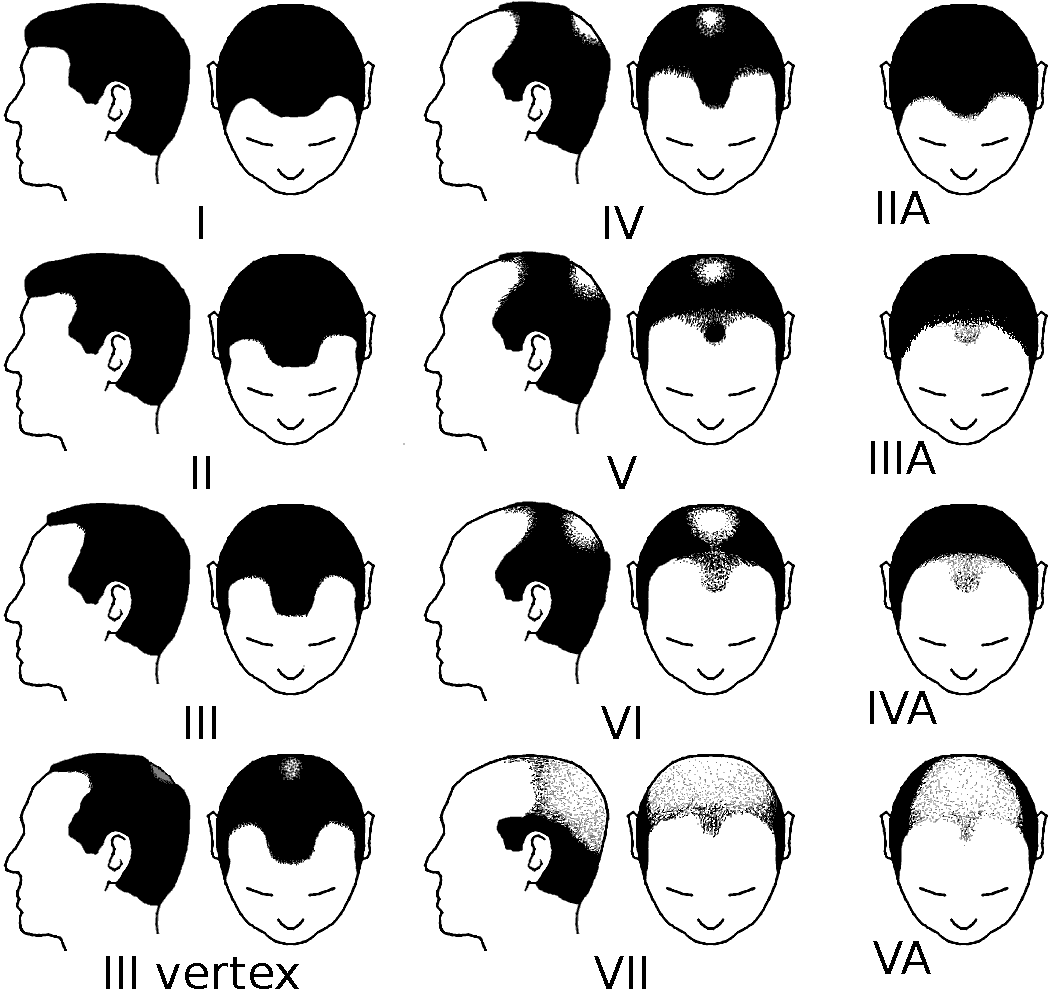Quick Summary: Hair Loss Stages in a Male (Norwood Scale)
- What is Male Pattern Hair Loss? Male pattern hair loss, or androgenic alopecia, is the most common cause of hair loss in men, often impacting confidence and well-being.
- The Norwood Scale: This scale classifies male pattern hair loss into seven stages, from minimal recession (Stage 1) to extensive baldness (Stage 7). It helps identify the stage of hair loss and guides treatment options.
- When to Seek Professional Help? Early intervention is crucial. Consult a hair transplant specialist for an accurate assessment and explore treatment options.
- Hair Loss Treatment Options: Treatments for hair loss vary depending on the cause. These can include Minoxidil, Finasteride, Platelet-Rich Plasma therapy, Hair transplants.
- Practical Advice for Managing Hair Loss: Maintain a healthy lifestyle, manage stress, and use gentle hair care practices.
- Conclusion: Understanding hair loss stages and seeking professional help can help manage and treat hair loss effectively. Schedule a consultation with our hair transplant specialists for personalised solutions.
Male pattern hair loss, also known as androgenic alopecia1, is the most common cause of hair loss in men. Even though hair loss is a natural part of ageing for many men, it can also be a source of concern, impacting confidence and overall well-being. Understanding the reasons behind hair loss and the stages it progresses through can empower you to take control of your situation.
What is the Norwood Scale?
The Norwood Scale is a recognized method of classifying the different stages of male pattern hair loss. It was developed in 1975 by revising the Hamilton classification chart2 to provide a visual guide to track the progression of hair recession and thinning. By understanding the Norwood Scale, you can identify your specific stage and explore potential treatment options.
The 7 Stages of Hair Loss on the Norwood Scale
The Norwood Scale classifies hair loss into seven stages, ranging from minimal recession (Stage 1) to extensive baldness (Stage 7)3. Each stage has distinct characteristics.

- Stage 1: This is the earliest stage with minimal or no receding hairline at the temples.
- Stage 2: A slight recession begins to form around the temples. This indentation is can be referred to as a maturing hairline and is a common characteristic seen in many men as they age.
- Stage 3: This stage marks the earliest stage of the Norwood scale to be considered as balding. In Norwood 3 hair loss, the hairline recedes further at the temples, forming a distinct “M,” “U,” or “V” shape. The recessed areas may be completely bare or show minimal hair growth. There’s a variation of Stage 3, known as Stage 3 Vertex. In this variation, the hairline remains at the Stage 2 position, but hair loss becomes evident on the crown of the scalp (vertex).
- Stage 4: Hair recession at the temples becomes more pronounced compared to Stage 2. Additionally, the vertex experiences significant thinning or complete baldness. These two areas of hair loss are separated by a band of hair that connects to the remaining hair on the sides of the scalp.
- Stage 5: The bald areas at the temples and vertex become larger than in Stage 4. While still separated, the band of hair connecting them thins considerably and may appear sparse.
- Stage 6: This stage signifies a significant advancement in hair loss. The previously separate bald areas at the temples and vertex merge into a single horseshoe-shaped bald region. The band of hair across the top of the head either disappears or becomes very sparse.
- Stage 7: This is the most advanced stage of hair loss on the Norwood Scale. Only a horseshoe-shaped fringe of hair remains on the sides and back of the head. This remaining hair is often fine and lacks density.
Norwood Class A
The Norwood classification system also acknowledges a less common hair loss progression known as Norwood Class A. This variation differs from the standard stages in two key aspects (Stages 2a, 3a, 4a, 5a):
- Hairline recession occurs uniformly across the front of the scalp, creating a straight receding line rather than leaving an isolated patch of hair in the centre.
- There’s no distinct bald area forming on the vertex (crown). Instead, the hairline recedes directly from the front towards the back of the scalp.
Uses of the Norwood Scale
The Norwood Scale transcends its role as a visual reference. Hair transplant clinics rely on it for several reasons:
- Communication: It establishes a common language for both patients and specialists.
- Guide Treatment Options: Understanding the stage of hair loss allows doctors to recommend the most appropriate treatment course, whether it’s medication, hair loss prevention strategies, or hair transplantation.
- Track Progress: The Norwood Scale can be used to monitor the effectiveness of treatment plans and assess overall progress.
When to Seek Professional Help?
Hair loss is a progressive condition, and early intervention is crucial. Whether you suspect you’re in the early stages (receding hairline) or later stages (scalp thinning, distinct bald patterns), scheduling a consultation with a hair transplant specialist is always recommended. A professional can accurately assess your specific situation, regardless of the Norwood stage you might identify yourself with. This expert evaluation allows for exploring the most suitable treatment options to potentially slow down hair loss, promote existing hair growth, and discuss long-term strategies for maintaining a healthy head of hair.
Hair Loss Treatment Options
Treatments for hair loss vary depending on the cause, addressing hair loss at different stages. These can include:
- Topical treatments: Products containing Minoxidil (Regaine) can help stimulate hair growth. Minoxidil potentially widens tiny blood vessels in the scalp, which improves blood flow to hair follicles. This process revives and extends the anagen (growth) phase of the hair cycle, shortens the telogen (resting) phase, stimulates hair follicle activity, increases follicle size, and boosts the production of crucial growth factors for hair development4.
- Prescription medications: Drugs like Finasteride are used for treating pattern baldness by blocking hormones that trigger hair loss. Dihydrotestosterone (DHT) is a hormone that is derived from testosterone. In people with male pattern baldness, too much DHT causes hair follicles to shrink and eventually stop growing back. Finasteride works by indirectly blocking DHT. By reducing DHT levels, Finasteride can help to prevent the process of hair loss and promote hair regrowth in men5.
- Minimally Invasive Procedures: Procedures like Platelet-Rich Plasma (PRP) Therapy involves extracting a small amount of the patient’s blood, processing it to concentrate the platelets, and injecting the platelet-rich plasma into the scalp. Platelets contain growth factors that can help stimulate hair follicle activity and promote hair regrowth. PRP therapy has shown promising results in treating various types of hair loss, including androgenetic alopecia6.
- Hair Transplant: A surgical procedure that involves transplanting healthy hair follicles from a donor area on the scalp to bald or thinning areas. This procedure can provide results that are both natural-looking and long-lasting, effectively restoring hair growth and improving appearance and self-confidence7.
Eligibility criteria for Hair Transplant Surgery
Not everyone is eligible to receive a hair transplant. Here are some of the general eligibility guidelines8:
- A stable hair loss pattern: Hair transplants are more effective when hair loss is predictable and stabilised with medications like Finasteride and Minoxidil.
- Sufficient donor hair: There needs to be a sufficient amount of healthy hair that can be extracted, typically from the back or sides of the scalp. If there is not enough donor hair, then the receding areas might not be fully covered. Having dense hair in the donor area is crucial also for effectively concealing the minimal scarring that occurs during the procedure.
Candidates in the latter stages of the Norwood Scale may face challenges due to the extensive area of baldness and the potential insufficiency of donor hair to cover these areas effectively. It is important for individuals considering a hair transplant to have realistic expectations and to consult with a qualified hair transplant surgeon who can assess their specific situation and provide tailored advice.
- Good overall health: Certain medical conditions or medications can impact the recovery process and success of a hair transplant. Conditions like diabetes, can increase the risk of infection due to slower wound healing. Cardiovascular conditions can also increase the risks of complications, while blood clotting disorders could result in excessive bleeding, disqualifying you as a viable candidate.
- Age considerations: There is no strict age limit for hair transplants, but it is usually recommended to wait until your late twenties when the hair loss pattern should have stabilised before having a hair transplant.
- Psychological considerations: While it is normal to feel some level of anxiety or stress before the procedure, conducting thorough research on a clinic and choosing a reputable surgeon can help minimise any concerns. The results of a hair transplant can also take months to be seen, so candidates will need to be mentally prepared to wait.
Practical Advice for Managing Hair Loss
While there’s no guaranteed way to prevent hair loss entirely, maintaining a healthy lifestyle with a balanced diet, managing stress, and using gentle hair care practices can all contribute to overall hair health. This may include:
- Diet: Ensure your diet is rich in essential vitamins and minerals that nourish hair follicles, such as iron, biotin, zinc and vitamin D.
- Stress Management: Chronic stress can contribute to hair loss. Techniques like meditation or yoga can help manage stress levels.
- Hair Care: Avoid harsh shampoos, excessive heat styling, and tight hairstyles that can put strain on hair follicles causing a condition called traction alopecia.
Conclusion
Hair loss is a common concern, but it’s not something you have to face alone. By understanding the stages of hair loss through the Norwood Scale and seeking professional help, when necessary, you can explore effective treatment options and regain confidence in your appearance. Schedule a consultation with our hair transplant specialists today to discuss personalised solutions for your specific needs. We offer a variety of advanced hair restoration techniques to help you achieve a natural-looking, fuller head of hair.
References
- Androgenetic alopecia: Medlineplus genetics. MedlinePlus. Available at: https://medlineplus.gov/genetics/condition/androgenetic-alopecia/#genes
- Norwood, O.T. (1975) ‘Male pattern baldness: Classification and incidence’, Southern Medical Journal, 68(11), pp. 1359–1365. Available at: https://pubmed.ncbi.nlm.nih.gov/1188424/
- Gupta, M. and Mysore, V. (2016) ‘Classifications of patterned hair loss: A Review’, Journal of Cutaneous and Aesthetic Surgery, 9(1), pp. 3. Available at: https://www.ncbi.nlm.nih.gov/pmc/articles/PMC4812885/
- Suchonwanit, P., Thammarucha, S., and Leerunyakul, K. (2019) ‘Minoxidil and its use in hair disorders: a review’, Drug design, development and therapy, 13, pp.2777–2786. Available at: https://doi.org/10.2147/DDDT.S214907
- Nestor, M. S., Ablon, G., Gade, A., Han, H., and Fischer, D. L. (2021) ‘Treatment options for androgenetic alopecia: Efficacy, side effects, compliance, financial considerations, and ethics’, Journal of Cosmetic Dermatology, 20(12), pp. 3759–3781. Available from: https://www.ncbi.nlm.nih.gov/pmc/articles/PMC9298335/
- Paichitrojjana, A. and Paichitrojjana, A. (2022) ‘Platelet-rich plasma and its use in hair regrowth: A review’, Drug Design, Development and Therapy, 16, pp. 635–645. Available at: https://doi.org/10.2147/DDDT.S356858
- Dunkin, M. and Gardner, S. (2022) Hair Transplants: What to Expect. WebMD. Available at: https://www.webmd.com/skin-problems-and-treatments/hair-loss/hair-transplants
- True, R. H. (2021) ‘Is every patient of hair loss a candidate for hair transplant? Deciding surgical candidacy in pattern hair loss’, Indian J Plast Surg, 54(4), pp. 435-440. Available at: https://www.ncbi.nlm.nih.gov/pmc/articles/PMC8719975/
Share:
Authored by
Reviewed by
Book a Consultation
Related Blogs
Jack Grealish’s Hair and Hairline
February 17, 2025
Jack Grealish is a professional football player who plays for England and Manchester City FC. His perfectly…
Jordan Pickford’s Hair and Hairline
February 16, 2025
Jordan Pickford is an accomplished English goalkeeper currently between the sticks from Everton FC. Performing at a…
Mo Salah’s Hair Transplant: Before, After, and His New Hairline
February 16, 2025
Mo Salah’s Hair transformation has sparked much speculation, with many people saying he has undergone a hair…
Can You Take Finasteride 3 Times A Week?
February 14, 2025
Quick Summary: Finasteride And Its Dosage Understanding Finasteride: Finasteride, a commonly prescribed medication for male pattern baldness,…
Dimitar Berbatov’s Hair Transplant: Before, After, and His New Hairline
February 11, 2025
Dimitar Berbatov was one of the most elegant footballers to grace the Premier League. During spells at…
Can Antidepressants Cause Hair Loss?
February 11, 2025
Quick summary: Can antidepressants cause hair loss? Have you noticed more hair in your brush or shower…
Jordan Peterson Hair Transplant: Before, After, and His New Hairline
February 10, 2025
Compared to his previous hairline, it is hard not to speculate that Jordan Peterson has had a…
LeBron James Hair Transplant: Before and After
February 7, 2025
For many years LeBron James could be seen on the basketball court with his hairline receding behind…
Collagen for hair loss: What you need to know
February 6, 2025
Quick summary: Collagen for hair loss: What you need to know Collagen is the most abundant protein…











